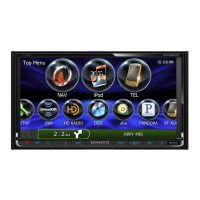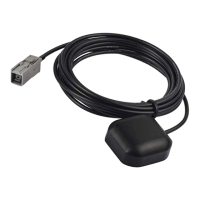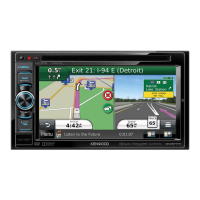
Do you have a question about the Kenwood DNX570HD and is the answer not in the manual?
| Resolution | 800 x 480 pixels |
|---|---|
| GPS Navigation | Yes |
| Bluetooth | Yes |
| USB Ports | 1 |
| HD Radio | Yes |
| Apple CarPlay | No |
| Android Auto | No |
| DVD Player | Yes |
| SD Card Slot | Yes |
| CD Player | Yes |
| iPod/iPhone Control | Yes |
| Steering Wheel Control | Yes |
| Backup Camera Input | Yes |
| Audio Formats Supported | MP3, WMA, AAC |
| Video Formats Supported | MPEG-1, MPEG-2, MPEG-4, WMV |
| SiriusXM | Yes (with optional tuner) |
Follow safety guidelines to prevent short circuits, monitor damage, and other hazards.
Guidelines for handling discs to prevent damage and ensure proper playback.
Instructions on how to protect the monitor from damage during operation.
Explanation of lens fogging and how to resolve it.
Potentially hazardous situations that could result in death or serious injury.
Potentially hazardous situations that may result in injury or property damage.
Key details regarding vehicle battery preservation and map data.
Select the language for the control screen and setting items.
Adjust the position of the monitor.
Set the terminal for iPod connection.
Details on the function and motion of each button on the front panel.
Details on the function and motion of each button on the front panel.
Basic functions like Menu, Return, and common menu key operations.
Common function keys and scrolling methods used in list screens.
How to scroll lists by flicking the screen.
Steps to access and display the main navigation screen.
How to find a destination and start route guidance.
Understanding route guidance, map icons, and route recalculation.
How to manually avoid traffic and view traffic maps.
Instructions for updating system software and map data.
How to connect Disc, iPod, and USB devices for music playback.
Basic playback controls and searching for tracks/files.
How to connect media for movie/picture playback.
Screen controls for movie and picture playback.
How to search for stations and use auto memory function.
Instructions for recalling saved stations and channels.
Steps to pair your Bluetooth-enabled cell phone with the unit.
Methods for initiating phone calls using the unit.
Using voice recognition for hands-free calling.
Important warnings and cautions before installing the unit.
List of included accessories to verify before installation.
Step-by-step guide for installing the main unit in the vehicle.
Instructions for safely removing the front trim plate.
Steps to detach and remove the main unit from the dashboard.
Diagram and instructions for connecting power, speakers, and sensors.
How to connect optional accessories like USB devices and iPods.
Information on intellectual property rights and trademarks used.
Regulatory compliance statements for FCC and Industry Canada.
Explanation of manual layout, link headers, reference marks, and icons.
Instructions for powering the unit on and off.
Setting parameters for rear and front cameras.
Configuration for North America sales area using commercial adaptors.
How to perform various functions from the Top Menu screen.
Personalizing the Top Menu by rearranging icons.
Steps to access and view the main navigation screen.
Managing audio sources while the navigation screen is active.
Displaying vehicle data and controlling satellite radio/media players.
Controlling playback from source and video screens.
Setting DVD menu items and controlling playback.
Enlarging the playback screen for DVD and VCD media.
Configuring playback functions like language, screen ratio, and parental level.
Setting disc parameters like CD Read and On Screen display.
Controlling playback and switching between simple and list screens.
Setting up USB, iPod, and DivX playback parameters.
Searching tracks, folders, and files by hierarchy.
Using category, link, folder, or thumbnail search for media files.
How to create an original playlist of favorite albums.
Adjusting movie playback from disc media.
Displaying and selecting devices for Pandora internet radio.
Performing functions on station and genre lists.
Accessing Aha mode and viewing content information.
Setting Aha location information for navigation destinations.
Basic operations for radio and HD Radio tuner.
Storing and recalling radio stations automatically or manually.
Choosing search methods for preset stations or categories.
Searching for stations based on program type.
Tuning by entering frequency/channel or selecting category/channel.
Using traffic information and setting radio receive modes.
Storing song information and tagging music for purchase.
Configuring parental codes, lock levels, and skip settings.
Setting alerts for content and selecting cities for weather information.
Steps to pair and connect Bluetooth devices.
Controlling audio playback from connected Bluetooth devices.
Methods for making and receiving phone calls hands-free.
Reading and creating SMS messages using the unit.
Configuring phonebook, SMS, and sorting preferences.
Setting audio output and auto pairing for devices.
Adjusting brightness, contrast, color, and dimmer settings.
Configuring rear and front camera types and settings.
Accessing user interface, touch panel, and memory settings.
Customizing beep, remote sensor, text scroll, and drawer close.
Selecting languages for menus, voice prompts, and text.
Calibrating the touch screen for accurate input.
Adjusting audio balance, subwoofer level, and car type.
Configuring speaker types, sizes, locations, and car types.
Adjusting fader, balance, volume offset, bass boost, and loudness.
Manually adjusting EQ curves and gain levels.
Selecting different audio sources for front and rear zones.
Applying sound effects like space enhancer and highway sound boost.
Adjusting sound realism, listening position, and DTA settings.
Overview of remote control buttons and their functions.
How to switch between DVD, NAV, and AUD operation modes.
Using the remote for direct searching of files, tracks, or chapters.
Troubleshooting common issues related to settings and audio operations.
Explanation of error messages and their corresponding causes and solutions.
Instructions for resetting the unit to factory settings.
List of supported media types and file formats.
Information on DVD region codes and operational marks.
List of DVD language codes and technical specifications.
Technical specifications for Bluetooth, tuners, video, and navigation.
Terms and conditions for using the embedded software.
Terms for using the NAVTEQ Traffic Data service.
Overview of navigation system usage and audio information.
How to access help and understand status bar icons.
Acquiring satellite signals and using the on-screen keyboard.
Creating and deleting shortcuts for the Where To? menu.
Methods to find locations using categories, search bars, or changing search areas.
Specific guides for finding fuel stations, addresses, cities, and intersections.
Locating places via coordinates, map browsing, or quick search lists.
Setting and managing home locations and saved places.
Organizing saved locations with categories and deleting them.
Steps for starting, previewing, and following navigation routes.
Interacting with the navigation map view and zoom controls.
Modifying routes by adding points, taking detours, or stopping navigation.
Managing speed limits and finding services near exits.
Customizing routes to avoid specific roads or areas.
Disabling custom avoidances and using off-road navigation mode.
Personalizing map display elements like layers, data fields, and buttons.
Adjusting map view perspective and removing map buttons.
Accessing trip logs and viewing detailed turn-by-turn directions.
Viewing junction views, traffic alerts, and trip statistics.
Managing trip data, viewing location, finding services, and getting directions.
Connecting to Smartphone Link for live data and disabling calls.
Subscribing to services and calculating fuel economy.
Understanding ecoChallenge scores and viewing fuel economy graphs.
Exporting mileage reports and viewing myGarmin messages.
Viewing weather forecasts, alerts, road conditions, and planning trips.
Viewing past routes, using world clock, and finding parking information.
How traffic information is received and interpreted.
Viewing traffic on your route and taking alternate routes.
Saving and viewing traffic cameras, and purchasing subscriptions.
Configuring navigation preferences and map display options.
Adjusting display settings and route calculation preferences.
Updating time, languages, adding security, and managing device settings.
Returning settings categories or all settings to default values.
Details on supported media types and file formats for playback.
Information on DVD region codes and operational marks.
List of DVD language codes and technical specifications.
Technical specifications for Bluetooth, tuners, video, and navigation systems.
Warranty terms and coverage for products purchased in the USA.
Warranty terms and coverage for products purchased in Canada.
Warranty terms and coverage for products purchased in Brazil.












